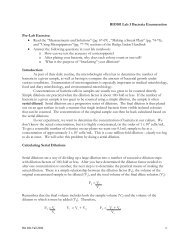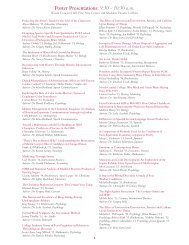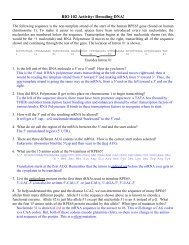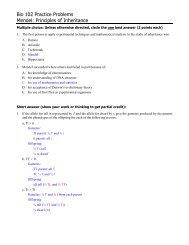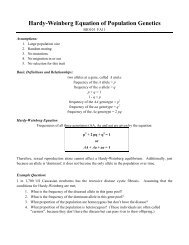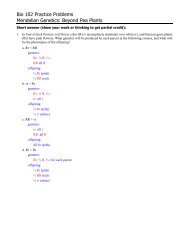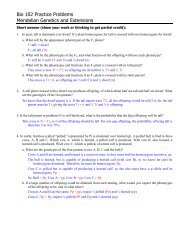Exam 1 Fall 2010
Exam 1 Fall 2010
Exam 1 Fall 2010
Create successful ePaper yourself
Turn your PDF publications into a flip-book with our unique Google optimized e-Paper software.
<strong>Exam</strong> 1<br />
BIO101, <strong>Fall</strong> <strong>2010</strong><br />
Name: ________________________________<br />
Multiple Choice Questions. Circle the one best answer for each question. (3 points each)<br />
1. The thorns on a cactus and quills on a porcupine would be an example of _______________ structures.<br />
A. tertologous<br />
B. homologous<br />
C. orthologous<br />
D. analogous<br />
E. paralogous<br />
2. What naturalist described the concept of natural selection?<br />
A. Jean-Baptiste de Lamarck<br />
B. Georges Buffon<br />
C. Carolus Linnaeus<br />
D. James Hutton<br />
E. Alfred Wallace<br />
3. Gene flow describes the movement of alleles between<br />
A. individuals.<br />
B. chromosomes.<br />
C. species.<br />
D. populations.<br />
E. parents and their offspring.<br />
4. Which type of selection is most likely to lead to speciation over a long period of time?<br />
A. Disruptive<br />
B. Hybridizing<br />
C. Directional<br />
D. Stabilizing<br />
E. None of these<br />
5. Multiple reproductive barriers can lead to<br />
A. a heterozygote advantage.<br />
B. genetic drift.<br />
C. parsimony.<br />
D. sympatric speciation.<br />
E. intrasexual selection.<br />
6. Which level of classification is most specific (in other words, includes the fewest organisms)?<br />
A. Kingdom<br />
B. Phylum<br />
C. Domain<br />
D. Order<br />
E. Class<br />
7. Mutations tend to accumulate most rapidly in what types of sequences?<br />
A. Genes essential for life<br />
B. Dominant alleles<br />
C. Regions between genes<br />
D. Orthologous genes<br />
E. Parsimonious genes<br />
Version A p. 1 of 7 Oct. 1, <strong>2010</strong>
8. A molecular clock relies upon the assumption that<br />
A. molecules are stable for long times.<br />
B. mutations in DNA accumulate at roughly a constant rate.<br />
C. matings are random in this population.<br />
D. prokaryotes are more easily classified than eukaryotes.<br />
E. derived characters have arisen recently.<br />
9. Over several thousand years, some species of fish that live in pools in dark caves have lost functional eyes. How<br />
might natural selection explain this loss?<br />
A. The loss is explained by the principle of “use and disuse”.<br />
B. The fish experienced harmful mutations that caused the loss of function.<br />
C. Natural selection cannot explain this loss, it only explains new innovations.<br />
D. Gene flow from outside of the caves led to the loss.<br />
E. In the dark, functioning eyes presented greater costs than benefits to the fish.<br />
10. If a gene is fixed in a population, then<br />
A. it likely arose by a founder effect.<br />
B. it shows neutral variation.<br />
C. there will be no homolog in related species.<br />
D. there is only a single allele.<br />
E. it must have arisen by a horizontal transfer.<br />
11. Humans have twelve different genes that clearly arose by ancient duplications and are all involved with<br />
transporting iron out of cells. These genes are all<br />
A. orthologs.<br />
B. tertologs.<br />
C. analogs.<br />
D. paralogs.<br />
E. unnecessary.<br />
12. There used to be millions of prairie chickens in Illinois but by the early 1990s, there were fewer than 50. This<br />
population of prairie chickens had very low levels of genetic variability and more than half the eggs failed to<br />
hatch. This evolutionary change is an example of<br />
A. average heterozygosity.<br />
B. directional selection.<br />
C. the bottleneck effect.<br />
D. natural selection.<br />
E. frequency-dependent selection.<br />
13. Birds and bats are very different animals with different evolutionary histories. Their wings are the product of<br />
A. allopatric speciation.<br />
B. artificial selection.<br />
C. convergent evolution.<br />
D. hybridization.<br />
E. postzygotic isolation.<br />
14. Why is the Kingdom Monera no longer recognized by biologists?<br />
A. Too many monerans were too difficult to classify.<br />
B. It was found to be polyphyletic.<br />
C. DNA sequences proved that monerans were plants.<br />
D. It has been absorbed into a different Kingdom.<br />
E. It has been replaced by a different, larger clade.<br />
Version A p. 2 of 7 Oct. 1, <strong>2010</strong>
15. Which of the following is not an observation or deduction on which natural selection is based?<br />
A. There is a struggle for limited resources and only a fraction of offspring survive.<br />
B. Individuals whose characteristics fit best with the current environment are more likely to leave more<br />
offspring.<br />
C. Populations have the capacity to increase very quickly.<br />
D. Poorly adapted individuals never produce offspring.<br />
E. There is heritable variation within a population.<br />
16. Engineers can design a limb on a robot that is much more versatile than those of any animal. Why are animal<br />
limbs not optimally arranged?<br />
A. Natural selection has not yet had sufficient time to make the optimal limb.<br />
B. Natural selection is limited to modifying structures that were present in previous generations.<br />
C. Too many different genes (each with many alleles) are needed to produce a limb for natural selection to<br />
work well.<br />
D. Because animals are diploid and reproduce sexually, natural selection struggles to improve structures.<br />
E. Our current understanding of evolution can’t explain why animal limbs aren’t optimal.<br />
17. Adaptive evolution can be caused by<br />
A. the bottleneck effect.<br />
B. gene flow.<br />
C. natural selection.<br />
D. genetic drift.<br />
E. any of the above answers.<br />
18. In the wild, two bird species are found living in the same tree and appear to be reproductively isolated. In<br />
captivity, it is found that the two species can breed and form viable, fertile offspring. Which one is most likely<br />
their natural reproductive barrier?<br />
A. Behavioral isolation<br />
B. Gametic isolation<br />
C. Mechanical isolation<br />
D. Habitat isolation<br />
E. Hybrid breakdown<br />
19. It has been observed that female fruit flies often prefer to mate with males with highly unusual characteristics,<br />
such as red eye color. This could be an example<br />
A. disruptive selection.<br />
B. frequency-dependent selection.<br />
C. a founder effect.<br />
D. heterozygote advantage.<br />
E. genetic drift.<br />
20. According to the punctuated equilibria model,<br />
A. most new species accumulate their unique features relatively rapidly.<br />
B. natural selection is less important than other mechanisms of evolution.<br />
C. given enough time, most existing species will branch gradually into new species.<br />
D. most evolution occurs in sympatric populations.<br />
E. speciation is most commonly due to a single, key mutation.<br />
Version A p. 3 of 7 Oct. 1, <strong>2010</strong>
21. Both Charles Lyell and Thomas Malthus had key ideas that helped Darwin formulate his ideas of descent with<br />
modification. Identify the key idea or observation that each person had and explain how that influenced Darwin.<br />
(10 points)<br />
Lyell:<br />
Malthus:<br />
22. Why is “survival of the fittest” not a great description of evolution? (4 points)<br />
23. Name the key term that is defined on each line. (3 points each)<br />
A structure of little or no importance to an organism which is an<br />
evolutionary remnant of a structure that was once important.<br />
A type of logic in which specific results are predicted from a<br />
general premise.<br />
A group of taxa that consist of a common ancestor and some,<br />
but not all, of its descendants.<br />
An alternative version of a gene.<br />
The selective advantage caused by a phenotype decreases as that<br />
phenotype becomes more common in a population.<br />
Distinct differences between two genders of a single species.<br />
An organism or cell containing two sets of chromosomes, one<br />
inherited from each parent.<br />
A frog that is carrying eggs that are ready to be fertilized.<br />
A group of populations with the potential to interbreed and yield<br />
healthy and fertile offspring.<br />
Version A p. 4 of 7 Oct. 1, <strong>2010</strong>
24. As we discussed in class, individuals who are homozygous for the Hb S allele have sickle cell disease. We take<br />
a random sample of 1,000 medical records from a population and find that 80 people have been diagnosed with<br />
sickle cell disease.<br />
24A. What assumptions about this population must be true for the population to be in Hardy-Weinberg<br />
equilibrium? (5 points)<br />
24B. Which of these assumptions is least likely to be true? Explain your reasoning. (4 points)<br />
24C. If those assumptions are met, what fraction of alleles in the population are Hb S ? What fraction of people<br />
in the population are heterozygous? (8 points; show your work for possible partial credit)<br />
24D. The Hb S allele is maintained in the human population because it provides some resistance to the disease<br />
malaria, which is an example of _______________________________________. (3 points)<br />
Version A p. 5 of 7 Oct. 1, <strong>2010</strong>
25. A proposed phylogenetic tree for 13<br />
Saccharomyces species is shown to the right.<br />
25A. On the diagram, draw a circle around a<br />
paraphyletic group. (2 points)<br />
25B. Circle each word on the list below that<br />
correctly describes the group shown in the<br />
dotted box. (2 points)<br />
Clade Family Monophyletic Paralog<br />
Phylum Polyphyletic Species<br />
25C. Draw a square box at the position on the tree<br />
that corresponds to the last common ancestor<br />
for S. paradoxus, S. unisporus and S.<br />
kudriavzevii. (2 points)<br />
25D. In these organisms, Saccharomyces is the<br />
name of the … (2 points; circle all that apply)<br />
Class Domain Family Genus Kingdom Order Phylum Species<br />
25E. Is S. exiguus more closely related to S. pastorianus or to S. kluyveri? Briefly explain your answer.<br />
(6 points)<br />
Version A p. 6 of 7 Oct. 1, <strong>2010</strong>
26A. When testing the “Good Genes” model, why did the scientists raise the tadpoles in both “high food” and “low<br />
food” conditions? (4 points)<br />
26B. When testing the “Good Genes” model, why did the scientists decide to study half-sibs? (4 points)<br />
27. Imagine a single population of squirrels living on an island. An earthquake struck two thousand years ago and<br />
effectively split the island in two. The resulting two islands each had a group of squirrels and are too well<br />
separated for the animals to move from one to the other. Do you expect these two groups to be different species?<br />
Why or why not? How might you determine if they were separate species or not? (7 points)<br />
Version A p. 7 of 7 Oct. 1, <strong>2010</strong>



